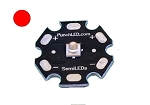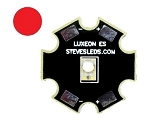Hey AFN, i'm going to start making a DIY Flower initiator. I'm waiting for supplies to show up in the mail. So I figure its a good time to ask for some advice.
this will go in a 5x5 tent, I currently have 170watt DIY COB and a Mars II 400 pulling 175 watts. so 340 combined watts. I was thinking of using about 5-10% of my total wattage for the flower initiator. Is this a safe starting point? so somewhere in the range of 20-35 watts of Flower Initiator power. Depending on what people suggest here.
I'll be receiving
12 Deep Red 670nm Leds SPECS: - Forward Voltage is 2.00V @ 350ma, 2.20V @700ma
12 Far Red 730nm Leds PECS: Forward Voltage is 2.35V @ 350ma, 2.6 @ 700ma
I couldn't decide on which driver to get so I got both of these Mean Wells, again with input from you guys i'll make my decision.
LDH-45B-700W W/Dimming output 21~64VDC max 44.8 Watts (24v power supply I Have).
APC-25-700 output 11~36VDC max 25 Watts
What ratio should I use for the Initiator array. 2-1, 3-1 or 1-1 of 670 to 730.. I think I bought enough for two grow tents.. lol, well they were cheap.. might as well buy enough for a second tent if needed.
They will be attached to two 36" 1/8" aluminum flat stock.
I've read that combining the two wavelengths is better than just the 730nm alone for initiating flower. Not entirely sure about this. But this is my experiment so i'm going to try it. If it works then, sahweeet. if not i'll just use the 730nm the next round.
Ok, so here we go. Any input is greatly appreciated as long as it is positive. Please refrain from starting some bitch cat fight in this journal. I have no patience for it. Save that for some other journal or forum. I'll ask for you to be booted from posting in this journal if you do. I Want this to be informative for others, I don't want to see 10 pages of 3-4 people bitchin back and forth while people are trying to learn. thanks
this will go in a 5x5 tent, I currently have 170watt DIY COB and a Mars II 400 pulling 175 watts. so 340 combined watts. I was thinking of using about 5-10% of my total wattage for the flower initiator. Is this a safe starting point? so somewhere in the range of 20-35 watts of Flower Initiator power. Depending on what people suggest here.
I'll be receiving
12 Deep Red 670nm Leds SPECS: - Forward Voltage is 2.00V @ 350ma, 2.20V @700ma
12 Far Red 730nm Leds PECS: Forward Voltage is 2.35V @ 350ma, 2.6 @ 700ma
I couldn't decide on which driver to get so I got both of these Mean Wells, again with input from you guys i'll make my decision.
LDH-45B-700W W/Dimming output 21~64VDC max 44.8 Watts (24v power supply I Have).
APC-25-700 output 11~36VDC max 25 Watts
What ratio should I use for the Initiator array. 2-1, 3-1 or 1-1 of 670 to 730.. I think I bought enough for two grow tents.. lol, well they were cheap.. might as well buy enough for a second tent if needed.
They will be attached to two 36" 1/8" aluminum flat stock.
I've read that combining the two wavelengths is better than just the 730nm alone for initiating flower. Not entirely sure about this. But this is my experiment so i'm going to try it. If it works then, sahweeet. if not i'll just use the 730nm the next round.
Ok, so here we go. Any input is greatly appreciated as long as it is positive. Please refrain from starting some bitch cat fight in this journal. I have no patience for it. Save that for some other journal or forum. I'll ask for you to be booted from posting in this journal if you do. I Want this to be informative for others, I don't want to see 10 pages of 3-4 people bitchin back and forth while people are trying to learn. thanks


